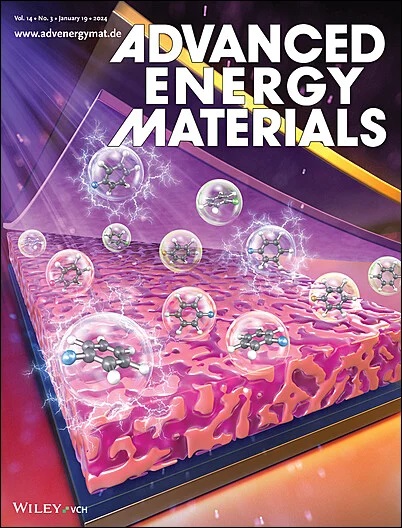Enabling High-Voltage Polymer-Based Solid-State Batteries Through Reinforcements with LiAlO2 Fillers
IF 24.4
1区 材料科学
Q1 CHEMISTRY, PHYSICAL
引用次数: 0
Abstract
Poor ionic conductivity, low Li+ transference number, and limited electrochemical stability plague all-solid-state Li-metal batteries based on solid polymer electrolytes (SPEs). One strategy to overcome these hurdles is the insertion of ceramic fillers to generate composite polymer electrolytes (CPEs). These are based either on active (ion-conductive) fillers like Li7La3Zr2O12 or passive (non-conductive) fillers like Al2O3. In this work, the effect of passive Li-containing fillers is showcased, exemplified by a CPE platform of poly(trimethylene carbonate) (PTMC:LiTFSI) with LiAlO2 particles. The inclusion of such fillers shows a strikingly positive effect. The ionic conductivity is greatly improved by one order of magnitude at 20 wt% of LiAlO2 compared to the pristine PTMC SPE. Moreover, the Li+ transference number is significantly boosted and reaches values close to unity (T + = 0.97 at 20 wt% of LiAlO2), effectively rendering the material a single-ion conductor. The CPEs show outstanding cycling stability vs Li-metal, and electrochemical stability of up to 5 V vs Li+/Li. When implemented in a solid-state battery cell with LiNi0.33Mn0.33Co0.33O2 (NMC111) and Li-metal, a stable cycling performance for over 100 cycles is observed. This demonstrates the potential of using microsized and cost-effective LiAlO2 fillers in CPEs for applications in all-solid-state Li-metal batteries.

用LiAlO2填料增强高压聚合物固态电池
基于固体聚合物电解质(spe)的全固态锂金属电池存在离子电导率差、Li+转移数低和电化学稳定性受限等问题。克服这些障碍的一个策略是插入陶瓷填料来产生复合聚合物电解质(cpe)。这些是基于活性(离子导电)填料,如Li7La3Zr2O12或被动(不导电)填料,如Al2O3。在这项工作中,以LiAlO2颗粒的聚碳酸三亚甲基(PTMC:LiTFSI) CPE平台为例,展示了被动含锂填料的效果。这类填充物的加入显示出惊人的积极效果。与原始PTMC SPE相比,在LiAlO2质量分数为20 wt%时,离子电导率大大提高了一个数量级。此外,Li+转移数显著提高,达到接近1的值(当LiAlO2的重量为20%时,T+ = 0.97),有效地使材料成为单离子导体。CPEs对锂金属具有良好的循环稳定性,对Li+/Li的电化学稳定性高达5 V。在使用LiNi0.33Mn0.33Co0.33O2 (NMC111)和锂金属的固态电池中实现时,观察到超过100次循环的稳定循环性能。这证明了在全固态锂金属电池中使用微型和具有成本效益的LiAlO2填料在cpe中的应用潜力。
本文章由计算机程序翻译,如有差异,请以英文原文为准。
求助全文
约1分钟内获得全文
求助全文
来源期刊

Advanced Energy Materials
CHEMISTRY, PHYSICAL-ENERGY & FUELS
CiteScore
41.90
自引率
4.00%
发文量
889
审稿时长
1.4 months
期刊介绍:
Established in 2011, Advanced Energy Materials is an international, interdisciplinary, English-language journal that focuses on materials used in energy harvesting, conversion, and storage. It is regarded as a top-quality journal alongside Advanced Materials, Advanced Functional Materials, and Small.
With a 2022 Impact Factor of 27.8, Advanced Energy Materials is considered a prime source for the best energy-related research. The journal covers a wide range of topics in energy-related research, including organic and inorganic photovoltaics, batteries and supercapacitors, fuel cells, hydrogen generation and storage, thermoelectrics, water splitting and photocatalysis, solar fuels and thermosolar power, magnetocalorics, and piezoelectronics.
The readership of Advanced Energy Materials includes materials scientists, chemists, physicists, and engineers in both academia and industry. The journal is indexed in various databases and collections, such as Advanced Technologies & Aerospace Database, FIZ Karlsruhe, INSPEC (IET), Science Citation Index Expanded, Technology Collection, and Web of Science, among others.
 求助内容:
求助内容: 应助结果提醒方式:
应助结果提醒方式:


